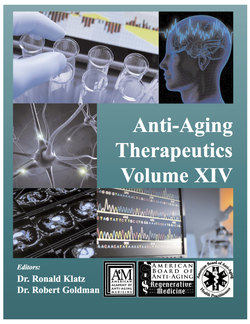Читать книгу Anti-Aging Therapeutics Volume XIV - A4M American Academy - Страница 22
На сайте Литреса книга снята с продажи.
INTRODUCTION
ОглавлениеChronic diseases including heart disease, diabetes, Alzheimer’s, and cancer account for 61% of deaths worldwide. Almost 45 % of these deaths occur prematurely before the age of 70. Fortunately though, most of these deaths are preventable by diet and lifestyle modification. The common factor causal for these chronic diseases may be insufficient nitric oxide (NO). Science has now shown that certain diets and moderate exercise can restore NO and positively affect these chronic diseases. The discovery in the 1980’s of the mammalian biosynthesis of NO and its roles in the immune1,2 cardiovascular3,5 and nervous6 systems established a startling new paradigm in the history of cellular signaling mechanisms. In fact, the discovery of NO was so profound that a Nobel Prize was awarded in 1998 to the 3 US scientists responsible for its discovery.
NO is one of the most important signaling molecules in the body, and is involved in virtually every organ system where it is responsible for modulating an astonishing variety of effects. NO has been shown to be involved in and affect every biological system in humans. One can then imagine the host of diseases or conditions that may be caused or affected by the body’s dysregulation of NO production/signaling. Maintaining NO homeostasis is critical for optimal health and disease prevention, and developing diagnostics and therapeutics to accomplish this will have a profound effect on public health. NO has a number of clinical applications including: inhaled NO for premature babies with pulmonary hypertension, treatment for erectile dysfunction and systemic hypertension, and many others. In fact, the release of NO from nitroglycerin is the mechanism of action for this drug, which has been used for over 160 years for the treatment of acute angina in cardiac patients.
The first pathway to be discovered for the endogenous production of NO was that involving L-arginine. For years, scientists and physicians have investigated L-arginine supplementation as a means to enhance NO production. This strategy has been shown to work effectively in young healthy individuals with functional endothelium or in older patients with high levels of asymmetric dimethyl L-arginine (ADMA), where the supplemental L-arginine can outcompete this natural inhibitor of NO production. However, patients with endothelial dysfunction, by definition, are unable to convert L-arginine to NO and, therefore, this strategy has failed in clinical trials. In fact, the Vascular Interaction With Age in Myocardial Infarction (VINTAGE MI) randomized clinical trial, concluded that L-arginine therapy (when added to standard postinfarction therapies) did not improve vascular stiffness measurements or ejection fraction, and was associated with higher postinfarction mortality.7 Thus, L-arginine should not be recommended following acute myocardial infarction (MI). However, there are also a number of studies showing benefit to patients taking L-arginine and just as many showing no benefit, no harm. Collectively, the literature suggests that strategies to enhance NO production through L-arginine supplementation are equivocal at best. Therefore there must be an alternative pathway for repleting NO in patients.
